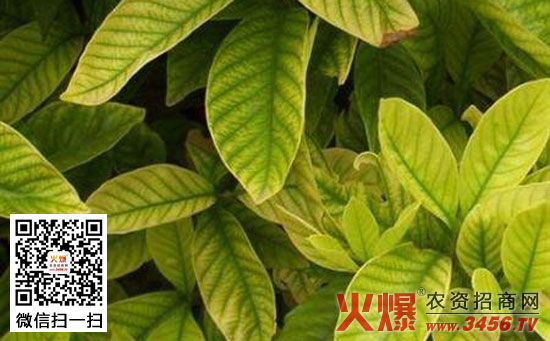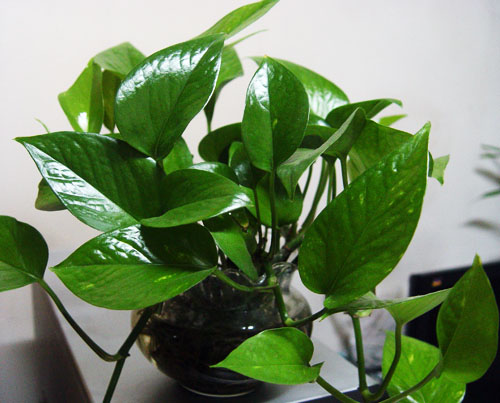Gardenia yellowing disease
Symptoms and pathological changes: chlorosis is an important physiological disease of gardenia. The disease is widely distributed and is common in the north of the Yangtze River. The disease mainly occurs in the leaves, starting from the young leaves at the top, the leaves fade, the mesophyll between the veins is yellow, and then the veins are also faded, and the edges of the leaves are yellow and white. Finally, brown spots appeared on the leaves and scorched inward from the tip and edge of the leaves. When the disease is mild, only the young leaves fade, and when the disease is serious, the whole plant is generally yellowed. The disease is caused by the lack of trace elements, often due to planting in alkaline soil, so that iron is fixed into an insoluble state, which makes it difficult for plants to absorb and utilize. The disease is more serious in winter and spring than in summer.
Prevention and control methods of gardenia yellowing: 1. The cultivated area should choose the soil with good drainage and slightly acidic and fertile. 2. 30 × 50 times sulfuric acid diluent was perfused around the rhizosphere of diseased plants, or 1000 times ferrous sulfate was sprayed on the leaf surface for 3 times to make the leaves turn green.

Symptoms of yellow disease of gardenia flower
The chlorosis of the leaf first occurs on the tender leaves at the tip of the branch, starts from the edge of the leaf, develops to the center of the leaf, the color of the leaf changes from green to yellow, gradually aggravates, the mesophyll becomes yellow or light yellow, but the vein is still green; then the whole leaf turns yellow, then yellowish white and white, and the edge of the leaf appears grayish brown to brown, necrotic and dry. For the whole plant, the top leaves suffered the most, the lower leaves were normal or close to normal, and the disease was serious, the plant weakened year by year, and finally died.
The pathogen of chlorosis of Gardenia jasmine
The disease is caused by unsuitable cultivation conditions, such as excessive stickiness of soil, excessive limestone, heavy alkalinity, low-lying moisture, insufficient supply of iron, etc., which is an important physiological disease.
Occurrence regularity of chlorosis of Gardenia jasmine
Calcareous soil area is easy to occur.
Prevention and treatment of chlorosis of Gardenia jasmine
1, horticultural control: to use well-drained, soft, fertile acid soil cultivation, pot planting can use mud and other acid soil, every 1-2 years to change the basin soil; the use of organic fertilizer, mixed with ferrous acid and zinc sulfate in organic fertilizer retting.
2. Chemical control: at the initial stage of the disease, the diseased plants were irrigated with 2% Mel 3% ferrous sulfate, or 0.1%-0.2% ferrous sulfate was sprayed on leaves, or iron integrants such as Guoguang EDTA-Fe, such as "Guoguang yellow, white green" or amino acid chelated iron, were sprayed and irrigated, and the effect was better before tapping.
How to prevent and cure gardenia yellowing?
Gardenia yellowing is a plant disease, which is easy to occur in calcareous soil areas.
1. Disease symptoms
The chlorosis of the leaf first occurs on the tender leaves at the tip of the branch, starts from the edge of the leaf, develops to the center of the leaf, the color of the leaf changes from green to yellow, gradually aggravates, the mesophyll becomes yellow or light yellow, but the vein is still green; then the whole leaf turns yellow, then yellowish white and white, and the edge of the leaf appears grayish brown to brown, necrotic and dry. For the whole plant, the top leaves suffered the most, the lower leaves were normal or close to normal, and the disease was serious, the plant weakened year by year, and finally died.
2. Disease pathogen
The disease is caused by unsuitable cultivation conditions, such as excessive stickiness of soil, excessive limestone, heavy alkalinity, low-lying moisture, insufficient supply of iron, etc., which is an important physiological disease.
3. Occurrence regularity
It is easy to occur in calcareous soil area.
4. Prevention and control methods
(1) Horticultural control: to use well-drained, soft, fertile acid soil cultivation, pot planting can use mountain mud and other acid soil, change the basin soil every 1-2 years; use organic fertilizer, mixed with ferrous acid and zinc sulfate in organic fertilizer retting.
(2) Pesticide control: at the initial stage of the disease, diseased plants were irrigated with 2% Mel 3 ferrous sulfate, or 0.1%-0.2% ferrous sulfate was sprayed on leaves, or iron was used in the soil, 22 cm (6 inch) flowerpot 0.2 grams. The treatment of chlorosis with drugs should be carried out at the initial stage of the disease, otherwise the effect is poor.
- Prev

Clove brown spot
Symptoms and pathological changes: mainly formed brown spots on the leaves, disease spots round, nearly round or irregular, dark brown edge, light brown center, severe brown spots, early defoliation, leaving only a small number of leaves in the whole plant. The pathogen is fungus, Cercospora lilac, the seed is spherical, dark brown, the conidium is fascicled and erect.
- Next

What diseases and insect pests are potted plants susceptible to?
The common diseases and insect pests of green radish cultivated indoors are leaf spot disease and root rot disease. Control method is: remove disease leaves, pay attention to ventilation; disease period spray 50% carbendazim wettable powder 500 times solution, and irrigation roots. Soilless cuttings usually do not have root rot after planting
Related
- Fuxing push coffee new agricultural production and marketing class: lack of small-scale processing plants
- Jujube rice field leisure farm deep ploughing Yilan for five years to create a space for organic food and play
- Nongyu Farm-A trial of organic papaya for brave women with advanced technology
- Four points for attention in the prevention and control of diseases and insect pests of edible fungi
- How to add nutrient solution to Edible Fungi
- Is there any good way to control edible fungus mites?
- Open Inoculation Technology of Edible Fungi
- Is there any clever way to use fertilizer for edible fungus in winter?
- What agents are used to kill the pathogens of edible fungi in the mushroom shed?
- Rapid drying of Edible Fungi

